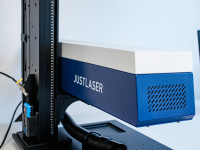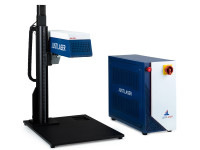UV lasers vs. CO₂, MOPA, and fiber lasers
Differences, areas of application, and selection guide for industry
Industrial material processing has developed rapidly in recent years. Lasers play a key role in this - be it in the marking of components, the precise cutting of a wide variety of materials or in structural surface processing. But anyone who believes that "the laser" is a universal technology is mistaken. There are considerable differences between the various laser types - both in terms of their physical properties and their suitability for certain materials and applications.
This article compares four of the most important industrial laser types: the UV laser, the CO ₂ laser, the fiber laser and the MOPA laser. The aim is to create a better understanding of which laser type is suitable for which tasks - and what the strengths and weaknesses of the respective technologies are.
Why different laser types are necessary at all
Although all laser types work according to the same basic principle - coherent, high-energy light focused on a single point - they differ in their wavelength, their pulse parameters and thus also in their interaction with different materials. These properties determine
- How deep the laser light can penetrate into a material
- Whether the material is melted, vaporized or chemically altered
- How precise and gentle the processing can be
- How high the energy input is - and whether it triggers thermal effects
Selecting the right type of laser is therefore a crucial step in project planning - especially when it comes to process reliability, marking quality and material integrity.
Technical basics at a glance
To make the differences tangible, a first look at the basic physical characteristics will help:
|
Laser type
|
Wavelength
|
Typical effect
|
Main principle of action
|
Suitable materials
|
|
UV laser
|
355 nm
|
Precise, thermally neutral marking
|
Photochemical
|
Plastic, glass, ceramics, coated metals
|
|
CO ₂ laser
|
10,600 nm
|
Cutting, engraving, melting
|
Thermal (strong absorption in organic materials)
|
Wood, acrylic, textiles, glass, rubber
|
|
Fiber laser
|
1.064 nm
|
Engraving, annealing marking
|
Thermal (high energy density)
|
Metals, technical plastics
|
|
MOPA laser
|
1,064 nm
|
Color markings, variable pulses
|
Thermal (pulsed, adjustable)
|
Metals, anodized aluminium, coloured plastics
|
This wavelength determines whether a material absorbs or reflects the light - and therefore whether it can be processed efficiently.
The UV laser - precision without heat damage
The UV laser, such as the one used in the new JustMark OSU from JustLaser, uses ultraviolet light in the 355 nm range. This extremely short wavelength has a decisive property: it enables a photochemical reaction in which the material is not melted or vaporized, but is changed or removed at a molecular level - without any significant heat input.
This so-called cold processing is particularly gentle and precise. There are no melting edges, no discoloration and no stress cracks. Even sensitive plastics, thin films or micro-structured surfaces can be marked precisely and permanently - without impairing the material properties.
Typical fields of application for UV lasers:
- Labeling of medical disposables (syringes, catheters, tubes)
- Engraving on glass bodies or quartz materials
- Serial numbers and microcodes on SMD components
- Structuring of technical ceramics
- Marking of multi-layered or flame-retardant plastics
Particularly in electronics and medical technology, there is no alternative to UV technology due to its precision and lack of thermal stress.
The CO₂ laser- tried and testedfororganic materials
The CO₂ laser is one of the oldest types of laser used in industry - and has established a firm place for itself to this day. With a wavelengthof 10,600 nm, it lies in the far infrared range. This wavelength is particularly well absorbed by organic and non-metallic materials, including wood, paper, acrylic, leather and textiles.
The effect is clearly thermal: the material is melted or vaporized, allowing fast cuts, deep engravings and decorative surface structures to be created.
Typical applications:
- Cutting of wooden panels, plywood or MDF
- Engraving on glass bottles or acrylic products
- Individualization of advertising materials (e.g. leather, rubber)
- Series production of foam packaging inserts
Advantages:
- High cutting speed
- Large processing fields can be realized
- Cost-efficient for large-volume materials
- Perfect for advertising technology, model making, furniture and interior design
For metals or technical plastics, however , the CO₂ laser is not the first choice - thereis a lack of absorption, whichmakes processing inefficient or even impossible.
The fiber laser - the workhorse for metals
Fiber lasers use a laser medium based on a doped glass fiber. Their wavelength is 1,064 nm, which is particularly well absorbed by metals. The high beam quality and energy density enable fast, permanent and high-contrast markings.
Typical applications:
- Annealing marking on stainless steel (e.g. dark codes without indentation)
- Deep engraving in tool steel or aluminum
- Marking of type plates, housings, machine parts
- Serial numbers on sheet metal parts or castings
Advantages:
- Long service life and energy efficiency
- Low maintenance and compact design
- Very economical for standard metal applications
- Ideal for integration into industrial manufacturing processes
However,there are limitations with sensitive or reflective materials such as copper or plastics without additives - this is where the fiber laser quickly reaches its limits.
The MOPA laser - the adaptable all-rounder
Technically speaking, the MOPA laser is a fiber laser with extended pulse control. MOPA stands for Master Oscillator Power Amplifier - and it is precisely this interaction that allows the pulse duration, pulse frequency and peak power to be individually adjusted.
This fine control enables special marking effects that cannot be achieved with conventional fiber lasers:
- Color annealing on stainless steel ( e.g. black, white, blue - completely without chemicals)
- Light markings on dark anodized aluminium parts
- Dark markings on light-colored or transparent plastics
- Avoidance of melting edges on thin materials
Typical areas of application:
- Premium products with decorative brand identification
- Medical or watch industry, where the highest contrasts are required
- Automotive interior parts in day-night design
- Applications with changing material types
The MOPA laser thus combines the industrial robustness of a fiber laser with the adaptability of a precision system - which makes it particularly attractive for versatile or design-oriented marking tasks.
Practical guide: Which laser for which material?
The following overview shows typical material-laser type assignments:
|
Material
|
Recommended laser type
|
Justification
|
|
Transparent plastic housing
|
UV laser
|
Cold marking without burning or discoloration
|
|
Stainless steel
|
Fiber laser or MOPA laser
|
Dark annealing marking or colored marking (MOPA)
|
|
Anodized aluminium
|
MOPA laser
|
Bright, high-contrast marking without depth ablation
|
|
Wood or acrylic panels
|
CO ₂ laser
|
Fast, clean cutting with a smooth edge
|
|
Glass or ceramic
|
UV laser or CO₂ (depending on the target)
|
UV: micro lettering & clarity, CO₂: matting or engraving
|
|
SMD components & printed circuit boards
|
UV laser
|
Microprint, no heat input, no damage to the function
|
|
Foils and blister packs
|
UV laser
|
Precise, non-contact direct marking without melting through
|
Conclusion: Choosing the right type of laser is not a matter of chance - it's a strategy
Industrial companies that want to make their production efficient, precise and material-compatible are faced with the task of selecting the right laser technology. The differences between UV, CO₂, fiber and MOPA lasers are not just of a technical nature - they have a direct impact on quality, process reliability and productivity.
While the CO₂ lasershows itsstrength in processing organic materials and the fiber laser is considered the standardsolutionformetal markings, UV and MOPA lasers offer real added value for particularly demanding, sensitive or design-oriented applications.
The new JustMark OSU UV laser from JustLaser was developed precisely for these cases: It offers uncompromising precision, works without thermal influences and can be flexibly integrated into production environments - ideal for companies that do not want to compromise when it comes to marking quality.



